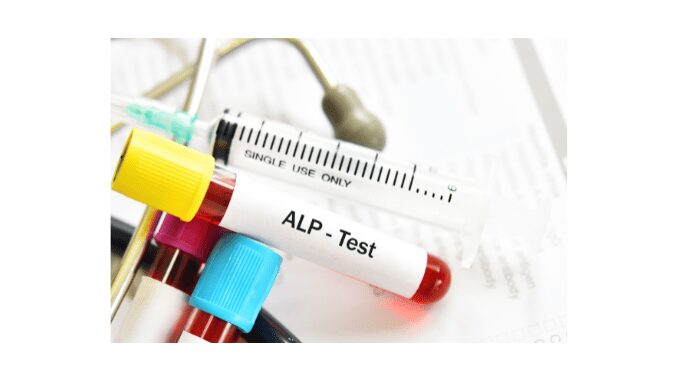
Alkaline phosphatase isoenzymes
Alkaline phosphatase (ALP) is present in the outer layer of the cell membrane. They are present in different body tissues and have different physicochemical properties. There are six types of alkaline phosphatase isoenzymes that are isolated by electrophoresis.
It is elevated in certain bone and liver diseases. ALP is useful for the diagnosis of rickets, hyperparathyroidism, carcinoma of Bone, and obstructive jaundice.
Isoenzymes of ALP
Isoenzymes of alkaline phosphatase (ALP) catalyzed the same reaction. ALP isoenzymes isolated by electrophoresis.
ALP is a monomer, the isoenzymes are due to the difference in the carbohydrate content (sialic acid residues). The most important ALP isoenzymes are α1-ALP, α2-heat labile ALP, α2-heat stable ALP, pre-β ALP, γ-ALP, etc.
An increase in α2-heat labile ALP is elevated in hepatitis, whereas pre-β-ALP indicates bone diseases.
1. α1-ALP
It is 10 percent of the total ALP. Alpha 1-ALP moves in the alpha 1 position in electrophoresis. It is elevated in obstructive Jaundice and biliary cirrhosis.
2. α2-heat labile ALP
This enzyme is stable at 56 C0 but loses its activity at 65 C0 when kept for 30 min. This enzyme increased in hepatitis.
3. α2-heat stable ALP
It is only 1% of ALP. Also alpha 2 but heat-stable isoenzymes. It is not destroyed at 65 C0 but inhibited by phenylalanine. It is found in normal pregnancy.
4. Pre-beta ALP
50% of ALP and which is most heat labile, loses its activity at 56 0C. This enzyme increased in rickets and Paget’s disease.
5. Gamma ALP
It is 10% of ALP and inhibited by phenylalanine. It is synthesized by intestinal cells and increased in ulcerative colitis and after gastrectomy surgery.
6. Leukocyte ALP
4% of total ALP is Leukocyte ALP. This enzyme elevated in lymphomas and decreased in chronic myeloid leukemia.
Properties of Alkaline phosphatase isoenzymes
- This enzyme is stable and works best in an alkaline medium.
- Alkaline phosphatase is dephosphorylates compound which means it removes a Phosphate group from molecules so that the molecule can freely diffuse into the cell.
- ALP hydrolase enzyme catalyzes hydrolytic removal of phosphate groups from mono-phosphoric esters including glycerophosphates, phenyl phosphates, nucleotides, and protein
- This enzyme removed 5’ phosphate groups from DNA or RNA and also removed phosphate from nucleotides. ALP shows activity on 5’ overhangs, recessed 5’ ends as well as blunt ends.
- The alkaline phosphatase enzyme is a type of apoenzyme. ALP consists of Zn2+ metal, which is called metalloenzyme. It can not work without Zn2+.
- Phosphate group attached with ester bond. Ester bonds break in the presence of water, this process is called monoester Phosphate hydrolysis. Amino acid serine is present on the active site of ALP. Removed phosphate comes on the active site of enzymes for the transient phase and forms a phosphorylated serine intermediate.
Source of ALP
Bacterial alkaline phosphatase
ALP obtained from E. Coli. This enzyme. This enzyme’s resistance to heat and detergent is an important property of these enzymes.
Calf Intestinal Phosphatase
It is isolated from calf intestinal mucosa. Its activity is similar to bacterial alkaline phosphatase.
Application
- Prevention of self-ligase vector
ALP removes Phosphate from the 5′ end and the OH group attached in the 5’ end, and the self-ligation process becomes stopped.
- Removal of 5’ phosphate group before end labeling
Before labeling ALP removes phosphate groups from the 5′ end of DNA or RNA strands.
Written By: Richa Pachori
